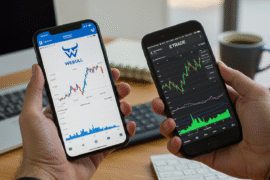This article may contain references to products or services from one or more of our advertisers or partners. We may receive compensation when you click on links to those products or services. Nonetheless, our opinions are our own.
If someone told you that the cost of an item is $100, an item you had never encountered before, would you say its cost is low, high, or fairly standard? It’s a ridiculous question, really, seeing as your ability to make an accurate assessment heavily depends on the data you have available.
The same thing applies to investing, but how do you find the right data? When you ask questions, everyone “knows” what’s best, and everyone overpromises. This is incredibly dangerous since it can fill you with false confidence. To avoid this, here are the top five tips for gathering data for your crypto investments.
Start by reviewing sources (rather than information)
Finding a few reputable portals is the first step, and it’s a big one. There’s no shortage of websites throwing around predictions, promising 100x returns, or hyping up the next big thing. Most of them have an agenda. Reliable sources like Techopedia and reputable news sites should be your go-to when looking for the best emerging cryptos to watch. Simply put, you need to stick to places that have a track record of accuracy rather than those that rely on clickbait headlines and paid promotions.
Also, having the right tools makes all the difference. Instead of manually digging through dozens of websites every day, use platforms like Messari, Dunae Analytics, or even Google Alerts. These tools help filter out the noise and keep you focused on relevant updates. You don’t need to spend all day scrolling through random tweets to stay informed. Let the right tools do the work for you.
Moreover, setting up notifications for keywords and portals can save you from missing critical updates. Crypto moves fast – faster than most markets. By the time you manually check everything, you might already be too late. Platforms like Twitter, Telegram, and Discord let you track updates instantly. Getting real-time alerts means you can react before the crowd does.
Don’t underestimate the power of joining groups. Reddit, Telegram, and Discord communities are filled with investors discussing trends, sharing insights, and analyzing data in real-time. However, don’t just take everything at face value. People love to push their own narratives, so always verify before acting. Still, these groups can give you an edge by exposing you to fresh perspectives and early information.
Verify on-chain activity
Blockchain explorers like Etherscan and BscScan exist for a reason – use them. Instead of relying on what influencers or project teams claim, you can see the raw data yourself. Hype doesn’t always match reality. A token might be trending on social media, but if the on-chain activity is dead, that’s a massive red flag.
Checking the wallet transactions of major holders can tell you what’s really happening. Are insiders accumulating, or are they dumping tokens on retail investors? Whales and early investors habitually make moves before announcements hit the public. If you notice a sudden sell-off before big news, you’ll know something’s off.
Token movements can reveal manipulation. If you see a project’s liquidity being shuffled between wallets or tokens moving in weird patterns, chances are something shady is going on. Pump-and-dump schemes, wash trading, and artificial volume inflation are all visible if you know where to look. A project with unnatural trading patterns is one to avoid.
Don’t compare on-chain activity to price action -compare it with market sentiment. A project might look promising, but if there’s little real activity behind it, the hype won’t last. Look at social engagement, developer activity, and transaction volume together. When the data and the narrative don’t align, it’s time to dig deeper.
Analyze developer activity
Checking GitHub for project updates is one of the easiest ways to gauge whether a crypto project is alive or just pretending to be. Developers constantly improve projects that are serious about long-term success. If a project hasn’t had a meaningful update in months, it’s probably a deadweight. Sure, you hoped you would use this project to retire early, but there’s no room for emotion in investment.
Commit frequency and code changes matter. It’s not just about updates – it’s about consistency. If you see constant work being done, that’s a great sign. Be skeptical if updates are sporadic or only happen when the team wants to hype up an announcement. Quality development happens year-round, not just before a token sale.
It is crucial to verify whether the team is actively fixing issues. Bugs happen, but how quickly they are addressed tells you a lot about the project’s priorities. If users report problems and they are ignored, that’s a problem. A strong team doesn’t just build – it maintains, improves, and engages with its community.
Avoid projects with little to no developer engagement. If GitHub is a ghost town, the team barely responds to community feedback, or they aren’t fixing problems and are ignored, that’s a problem. A strong team doesn’t just build – they maintain, improve, and engage with their community.
Study tokenomics and market impact
A token’s total supply and distribution can make or break its value. Scarcity drives demand, but too much of a token in circulation can tank prices. Also, if insiders or a few whales hold most tokens, you’re at their mercy. They can dump at any time, crashing the price.
Vesting schedules and lock-up periods are key. If a project releases tokens all at once, expect volatility. Gradual unlocks show a project is thinking long-term. However, if early investors get a massive supply before retail, you’re probably being set up as exit liquidity. Always check when and how tokens unlock.
Liquidity and trading volume tell you whether a token is actually usable or just another speculative bet. Low liquidity means price manipulation is easy, and low trading volume makes it hard to enter or exit positions without major price swings. If there’s no steady liquidity, even good fundamentals won’t save the token.
Sustainability matters. A project with solid incentives keeps users engaged. Staking rewards, governance benefits, and ecosystem utility all contribute to long-term value. If a token’s only purpose is speculation, it’s just a matter of time before the hype fades and the price follows. Strong tokenomics means people actually want to hold the token, not just flip it.
Compare historical trends and market cycles
Looking at previous price patterns helps you understand where the market might be headed. Crypto moves in cycles, and patterns tend to repeat. Most people jump in with high prices and panic sell when they drop. Studying past movements allows you to spot when the market is actually in accumulation or distribution.
Current sentiment often mirrors past bull and bear cycles. When people start saying, “This time is different,” it usually isn’t. The fear and greed cycle plays over and over. Recognizing this can help you make rational decisions instead of getting caught up in emotional trading.
Correlations with Bitcoin’s price movement can’t be ignored. Altcoins rise and fall based on what Bitcoin does, even if they have strong fundamentals. If Bitcoin is crashing, don’t expect yoru favorite altcoin to magically hold strong. Understanding these relationships lets you plan your trades better and avoid unnecessary risks.
External factors like regulations and global events play a role. A major crackdown on crypto in one country, a shift in monetary policy, or even economic instability can impact the market. Studying historical trends isn’t just about charts – it’s about understanding how external forces shape price action. The more context you have, the better your decisions will be.
Wrap up
Regarding crypto, bad data is worse than no data at all. If you’re basing decisions on hype instead of hard facts, you’re setting yourself up for failure. Just because something looks good now doesn’t mean it’ll hold up under scrutiny. Always check the numbers, verify the sources, and dig into the details before putting your money on the line. Moreover, if you’re willing to put in the effort, you’ll have a huge advantage over the people blindly following trends.

Reviewed and edited by Albert Fang.
See a typo or want to suggest an edit/revision to the content? Use the contact us form to provide feedback.
At FangWallet, we value editorial integrity and open collaboration in curating quality content for readers to enjoy. Much appreciated for the assist.
Did you like our article and find it insightful? We encourage sharing the article link with family and friends to benefit as well - better yet, sharing on social media. Thank you for the support! 🍉
Article Title: 5 Tips for Gathering Data for Your Crypto Investment Research
https://fangwallet.com/2025/02/17/5-tips-for-gathering-data-for-your-crypto-investment-research/The FangWallet Promise
FangWallet is an editorially independent resource - founded on breaking down challenging financial concepts for anyone to understand since 2014. While we adhere to editorial integrity, note that this post may contain references to products from our partners.
The FangWallet promise is always to have your best interest in mind and be transparent and honest about the financial picture.
Become an Insider

Subscribe to get a free daily budget planner printable to help get your money on track!
Make passive money the right way. No spam.
Editorial Disclaimer: The editorial content on this page is not provided by any of the companies mentioned. The opinions expressed here are the author's alone.
The content of this website is for informational purposes only and does not represent investment advice, or an offer or solicitation to buy or sell any security, investment, or product. Investors are encouraged to do their own due diligence, and, if necessary, consult professional advising before making any investment decisions. Investing involves a high degree of risk, and financial losses may occur including the potential loss of principal.
Source Citation References:
+ Inspo










































